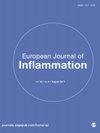Potential role of interleukin-33 in systemic lupus erythematosus by regulating toll like receptor 4
IF 0.6
4区 医学
Q4 IMMUNOLOGY
引用次数: 1
Abstract
Introduction Systemic lupus erythematosus (SLE) is an autoimmune disease characterized by immune activation and multi-immunologic phenotypes. Interleukin-33 (IL-33) has been shown to be a critical and pleiotropic immunoregulatory mediator in the pathogenesis of many autoimmune diseases. At present, there are conflicting findings in the research of IL-33 in SLE. The purpose of this study was to investigate whether and how IL-33 is involved in the occurrence and development of SLE. Methods 43 SLE patients and 43 healthy volunteers were recruited for this study. Serum levels of IL-33, IL-4, IL-6, IL-10 and IL-21 were measured by ELISA. The expression of IL-33 was investigated in kidney sections by immunohistochemistry in lupus nephritis patients (n = 5) and controls (n = 3). The mRNA expressions of Toll like receptor 4 (TLR4), TLR2, and tumorigenicity 2 (ST2)L were quantified in peripheral blood mononuclear cells (PBMCs) by real-time PCR. The surface expression of TLR4 on T cells, B cells, monocytes, and neutrophils was assessed by flow cytometry (n = 22). Mann–Whitney U-test and Spearman’s test were used for statistical analysis. Results Serum concentrations of IL-33 were significantly higher in SLE patients than in healthy controls (p < 0.0001). IL-33 expressions were positively correlated with IL-4 and IL-6 levels in SLE patients, which play pivotal roles in the autoantibody production. In addition, TLR4 and TLR2 mRNA were markedly increased in PBMCs from SLE patients (p < 0.05). TLR4 was positively associated with IL-33, while TLR2 was not. Conclusions These results imply that upregulated expression of serum IL-33 together with increased TLR4 in PBMCs may contribute to the pathogenesis of SLE via promotion of inflammatory cytokines production.白细胞介素-33通过调节toll样受体4在系统性红斑狼疮中的潜在作用
系统性红斑狼疮(SLE)是一种以免疫激活和多种免疫表型为特征的自身免疫性疾病。白细胞介素33(IL-33)在许多自身免疫性疾病的发病机制中已被证明是一种关键的多效性免疫调节介质。目前,对SLE患者白细胞介素33的研究存在争议。本研究的目的是探讨IL-33是否以及如何参与SLE的发生和发展。方法选择43例SLE患者和43名健康志愿者进行研究。ELISA法测定血清IL-33、IL-4、IL-6、IL-10和IL-21水平。通过免疫组织化学方法研究了狼疮性肾炎患者(n=5)和对照组(n=3)肾切片中IL-33的表达。通过实时PCR定量外周血单核细胞(PBMC)中Toll样受体4(TLR4)、TLR2和致瘤性2(ST2)L的mRNA表达。通过流式细胞术评估TLR4在T细胞、B细胞、单核细胞和中性粒细胞上的表面表达(n=22)。Mann-Whitney U检验和Spearman检验用于统计分析。结果SLE患者血清IL-33浓度明显高于健康对照组(p<0.0001),IL-33的表达与SLE患者血清中IL-4和IL-6水平呈正相关,在自身抗体的产生中起着关键作用。此外,SLE患者PBMC中TLR4和TLR2mRNA显著增加(p<0.05),TLR4与IL-33呈正相关,而TLR2与IL-33不呈正相关。结论PBMC中血清IL-33的表达上调和TLR4的增加可能通过促进炎性细胞因子的产生而参与SLE的发病机制。
本文章由计算机程序翻译,如有差异,请以英文原文为准。
求助全文
约1分钟内获得全文
求助全文
来源期刊
CiteScore
0.90
自引率
0.00%
发文量
54
审稿时长
15 weeks
期刊介绍:
European Journal of Inflammation is a multidisciplinary, peer-reviewed, open access journal covering a wide range of topics in inflammation, including immunology, pathology, pharmacology and related general experimental and clinical research.

 求助内容:
求助内容: 应助结果提醒方式:
应助结果提醒方式:


